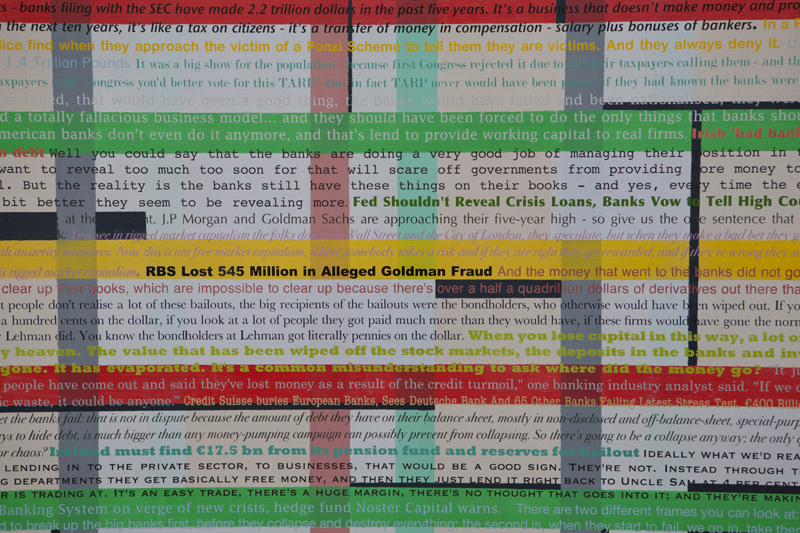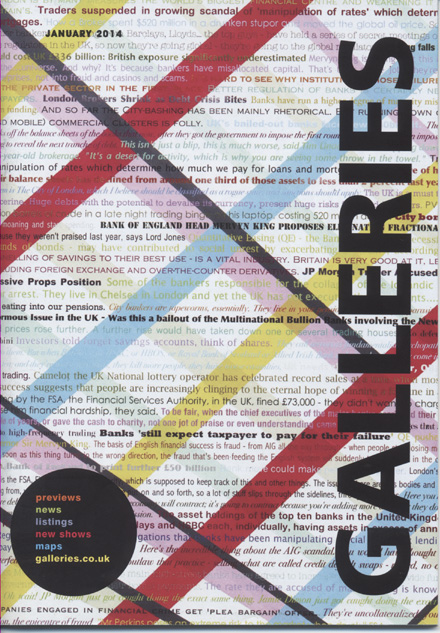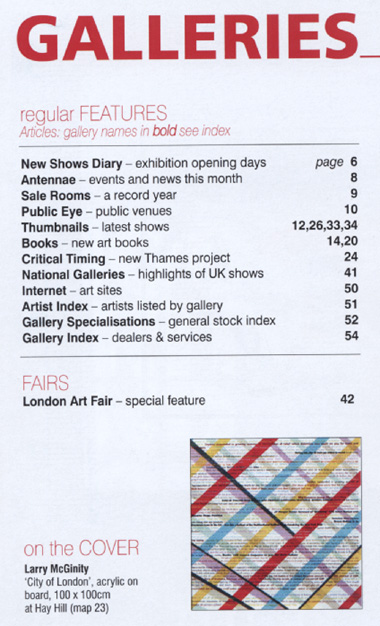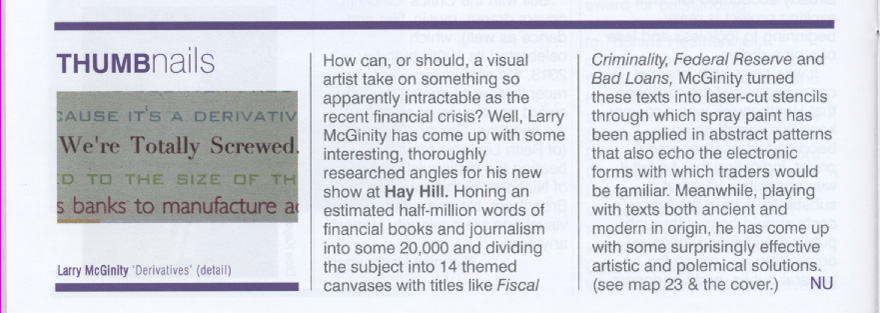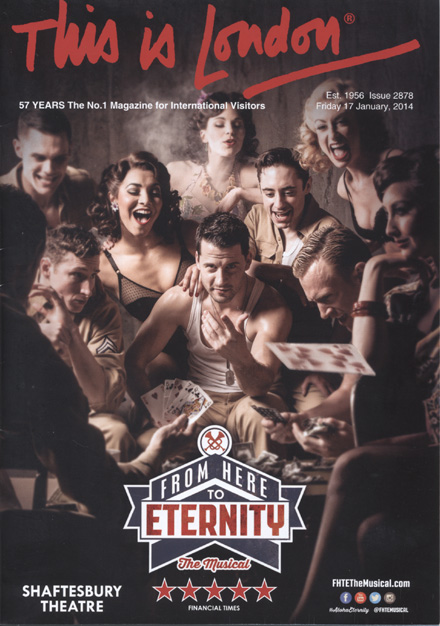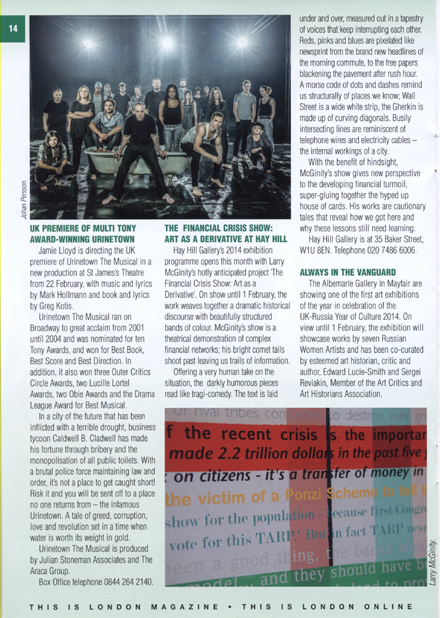 home
about
artists
exhibitions press
contact
purchase
home
about
artists
exhibitions press
contact
purchase |
|
|
LARRY McGINITY - PRESS
Financal
crisis art is totally derivative
by Gabriella Griffith
HISTORICALLY, some of the world’s finest artworks
have been inspired by events at the time; Picasso’s Guernica,
Hogarth’s Rake’s Progress, Banksy’s Jubilee-themed sweatshop boy on
the wall of Poundland. So financial crisis-inspired artist Larry
McGinity is in very good company.
McGinity has created 14 paintings for his exhibition:
The Financial Crisis Show: Art As A Derivative. The pieces, which
have titles such as High Frequency Trading and MF Global, are
showing at the Hay Hill Gallery on Baker Street (until 1 Feb if
you’re game).
The paintings are driven by an interest in the way
people explained the financial crisis and are made of text,
including the hallowed words of Lord [Mervyn] King and George Soros,
intermingled with bright flashes of colour.
The exhibition has had plenty of relevant visitors,
“I’ve had people here from all the big banks, Deutsche Bank, JP
Morgan, Lloyds, Goldman Sachs... The word I’ve heard most is
‘intrigued’,” McGinity told The Capitalist.
Will the City’s financial firms be in a huge rush to
buy up the pieces? We’re not sure, but we bet the former governor
never dreamed his speeches would be deemed a work of art.
This is London, Friday 17 January, 2014, Issue 2878. Offering a very human take on the situation, the
darkly humorous pieces read like tragi-comedy. The text is laid
under and over, measured out in a tapestry of voices that keep
interrupting each other. Reds, pinks and blues are pixelated like
newsprint from the brand new headlines of the morning commute, to
the free papers blackening the pavement after rush hour. A morse
code of dots and dashes remind us structurally of places we know;
wall Street is a wide white strip, the Gherkin is made up of curving
diagonals. Busily intersecting lines are reminiscent of telephone
wires and electricity cables - the internal working of a city. With the benefit of hindsight, McGinity's show gives
new perspective to the developing financial turmoil, super-gluing
together the hyped up house of cards. His works are cautionary tales
that reveal how we got here and why these lessons still need
learning. Hay Hill Gallery is at 35 Baker Street, W1U 8EN.
Telephone 020 7486 6006. FAD Magazine
The
Financial Crisis Show – Art as a Derivative It
could hardly be more timely. Just days after HSBC have agreed to pay
a $1.9 billion dollars in a record settlement with US regulators
over money laundering allegations, a new exhibition opened yesterday
at the Hay
Hill Gallery on Baker
Street that brings to life some of the myriad voices involved in the
financial crisis. The
Financial Crisis Show – Art as a Derivative is a series of fourteen
thematic paintings by artist and art historian Larry McGinity.
Produced out of a period of extensive research, each work includes
around 1,500 words of verbatim text that explores a different aspect
of the occasionally impenetrable goings-on of financial markets.
How did the idea for the series
first originate? So I
decided to turn my studio into an office and research centre. I
would get up every day at 6am to listen to Bloomberg Trading. I
worked the same hours as financial sector workers, listening to Max
Keiser and American financial TV. I wangled my way into conferences
on foreign exchange, and assembled an enormous body of verbatim text
from the likes of Paul Wilmott, a specialist in algorithmic trading,
Scott Patterson, author of Dark Pools, and Michael Lewis, who wrote
The Big Short. By
the end, I had about half a million words in piles of differently
coloured notebooks. These were then typed up and grouped
thematically. There were fourteen key themes that kept cropping up,
and each one formed the basis for a painting. Each finished work
contains approximately 1,500 words of verbatim text, including
quotes, comments and headlines.
Your approach is quite unusual in
that it’s so rooted in language. I can only really think of Fiona
Banner among current artists to have featured so much text in their
work. What led you towards this particular approach? Text
is not a new thing in my work, but I wanted to get away from using
text as a slogan, and examine how it functions as hard data, as
information. I was especially interested in trying to play with
language, to create dialogue and interruption through the coming
together of different voices. I realised that in the world of
finance, there were many voices, something seemingly not understood
by conventional media. I met many people in finance who were
incredibly angry, who warned about what was about to happen. There’s
people with that Brooklyn twang, pukka bullion chaps, four Nobel
Laureates, the hopefuls at the ratings agencies…It’s a very human
story – full of drama, and full of humour too. But
you’re also clearly interested in the visual aspects of language. Well
I also wanted it to look beautiful! I wanted every word to be
leveraged, amped up, in the same way that banks had over-leveraged,
borrowed too much. So different quotations are in different fonts to
identify the different voices. I was using typology as a dynamic
force to accentuate language, and have some fun with it as well. So
something like Benjamin Gothic has an air of ambiguity or duplicity.
Plus all the fonts have their own names and that becomes part of it
too. I used Rockwell for heavy, pithy statements.
How did you approach the
composition of each work? I
also wanted to pay tribute to the Modern art movements that I had
been researching at the time. You can see nods to Malevich’s squares
in works like Bad Loans, and elsewhere touches of De Stijl and
Constructivism. Once
you had whittled down the text you wanted to use and worked out the
composition, what was the process of actually making the
paintings? Each
board is 100cm x 100cm. I primed them with gesso, then painted the
grounding to map out the design and composition to correlate to the
subject. Then I used laser-cut stencils and spray paint to apply the
text. I wanted it to be as clean as could be, so that whatever was
being said was accorded equal concentration and reverence, whether I
liked it or not. So many decisions are made by machine without human
interference – especially in the world of finance where all
information, ultimately, is expendable. So as opposed to algorithms,
I wanted to create a chiselled, hieroglyphic object – something that
could make a physical, slow, concrete reference to these things.
“Art as a Derivative” is quite a
provocative subtitle. What was the thinking behind that?
Have things improved since you
started work on the project?
Words : Tom Jeffreys The Financial Crisis Show – Art as a Derivative is at the Hay Hill
Gallery from 6th January to 1st February 2014. |
|
|
|
E-mail: info@hayhillgallery.com |
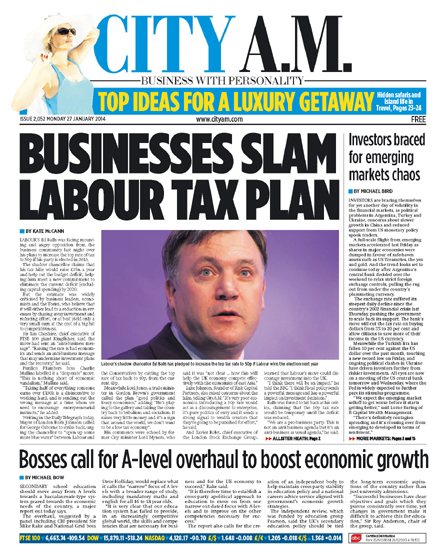
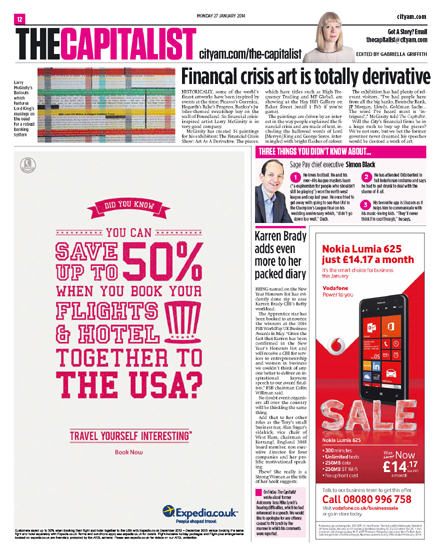

 http://www.cityam.com/article/1390796092/financal-crisis-art-totally-derivative?utm_source=website&utm_medium=TD_diary_right_col&utm_campaign=TD_diary_right_col
http://www.cityam.com/article/1390796092/financal-crisis-art-totally-derivative?utm_source=website&utm_medium=TD_diary_right_col&utm_campaign=TD_diary_right_col